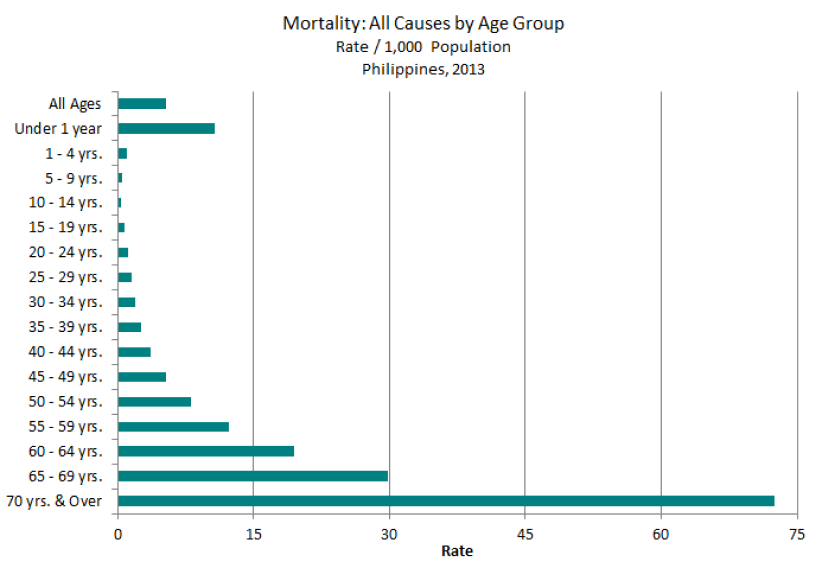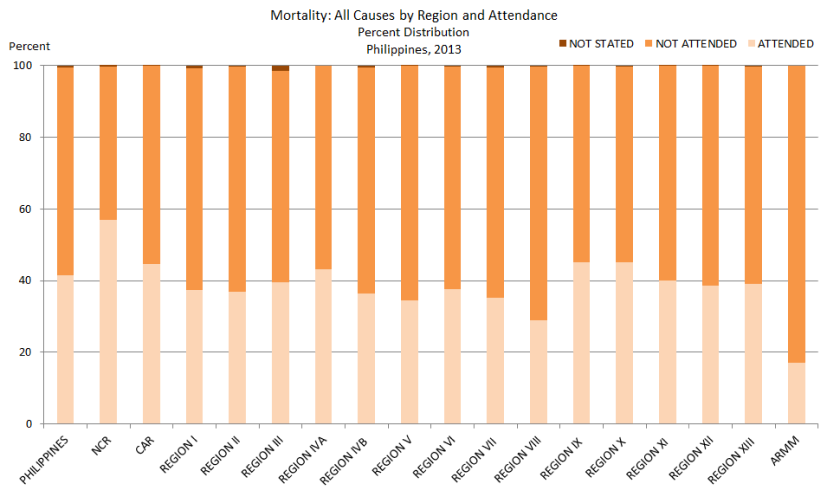Statistics
Statistics
Health Status
Health Status
Disease Surveillance
Morbidity
Mortality
Our mortality statistics provide a window into the intricate tapestry of public health in the Philippines. This data offers a glimpse into the ebb and flow of life, revealing patterns of health challenges, progress, and the impact of healthcare initiatives.
Mortality: All Causes by Age Group

In the Philippines, more than five people die for every one thousand population in 2013. This is equivalent to 531,280 registered deaths from all causes and all ages. Of these deaths, 57 percent or 304,516 were males and 43 percent or 226,764 were females. For every 100 female deaths, there correspond 134 male deaths and which constituted to a death sex ratio of 1.34. It is consistent that numbers of male deaths are greater than female deaths. Consequently, males always have higher death rate than females. Reports also showed that the highest occurrences of deaths were among the elderly persons, 70 years and over. It comprised more than 38 percent of total deaths with 202,564 cases. However, death occurrence was least among age group 10-14 years with 0.9 percent. Deaths among under 1 year old is more than twice (21,992 or 4.1%) the number of deaths in ages 1-4 years (9,526 or 1.8%) The number of deaths increase as the people gets older. Statistics show that the risk of dying is directly proportional to age, starting with age 10 and up.
Mortality: All Causes by Attendance and Region

Across all regions, only NCR showed a higher proportion of attended deaths by a medical doctor at the time of death than not. There is a difference of 14.4 percentage points (57.0 against 42.6%). For several years now, statistics show that even in NCR, a highly urbanized region and where both public and private health facilities are accessible, still, a low percentage of attended death is recorded. Dying without the attention of a medical doctor could be somehow an evidence of unaffordable health cost in the country.
Mortality: Ten (10) Leading Causes

Out of 514,745 deaths registered in 2013, more than 81 percent (433,375) were attributed to the top ten leading causes of death for the year. Deaths from all other causes comprised less than 20 percent of total deaths or 97,905 cases. More than one in every five deaths was caused by Diseases of the Heart making it the number one leading cause of death. Diseases of the Heart remained to be the first with 118,740 deaths. It recorded a 22.3 percent share from total deaths.
Diseases of the Heart had been consistently the number one cause of death for several years now. The 2013 number of deaths from this condition is 6,159 deaths (5.4%) higher than what was reported in 2012 which had 112,581 deaths. This year’s number of deaths from Diseases of the heart comprised 22.3 percent of total deaths. More males than females die from this cause. Out of 118,740 cases reported, 66,612 or 56 percent were males and 52,128 or 44 percent were females. Thus, the death sex ratio for Diseases of the Heart was 1.28 or 129 males in every 100 females.
The next three diseases in the list which remained in their respective rankings for the past four years already were, Diseases of the Vascular System (68,325; 12.9%), Malignant Neoplasm (53,601; 10.1%) and Pneumonia (53,101; 10.0%).
Mortality: Ten (10) Leading Causes by Sex

Eight out of the ten leading causes of deaths were male dominated. Female deaths were only higher than male deaths in Malignant Neoplasms and Diabetes Mellitus cases. Furthermore, there was a significant difference in number of fatalities from Accidents between male and female. From the total 40,071 deaths from Accidents, 77.9 percent or 31,218 cases were male and only 22.1 percent or 8,853 were female. This means that men were almost four times more likely to die from Accidents than women. Nonetheless, the same killer diseases were identified as the ten leading causes of death for separate groups of male and female, which differed only in ranks when tabulated by sex.
Mortality: Ten (10) Leading Causes by Attendance

More deaths from the leading causes were not medically attended. Majority of deaths or nine out of the top ten killer diseases were not attended by a medical doctor or any allied health officer in anytime during their illness or injury. Deaths from Certain Conditions Originating in the Perinatal Period was the only disease group causing death that showed higher percentage of cases which had been attended by a medical doctor or allied health professional.
Infant Mortality: Ten (10) Leading Causes

In 2013, although the infant mortality rate slightly increased, the number of registered infant deaths slightly decreased by more than one percent, from last year’s 22,254 cases to 21,992 cases. It comprised of 4.1 percent of the total deaths (531,280) reported during the year. This represented a daily average of 60 infant deaths and was equivalent to an Infant Mortality Rate (IMR) of 12.5 deaths per thousand live births. The top three leading causes of infant mortality were Pneumonia (3,146; 14.3%); Bacterial sepsis of newborn (2,731; 12.4%); and Respiratory distress of newborn (2,347; 10.7%). The listed top ten leading causes of infant mortality in 2013 were the same with what was recorded in 2012 which only differ in ranks.
Fetal Deaths: by Attendance

The total numbers of registered fetal deaths were 7,474 which was equivalent to a fetal death ratio (FDR) of 4.2 per one thousand livebirth. There was a decrease in number of about 4.9 percent from previous year’s fetal deaths. This was translated to an average of more than 20 fetal deaths per day for the year 2013. Almost all (99.1%) of fetal deaths were attended by qualified medical professionals such as physician, nurse and midwife. The rest or 0.9 percent were attended by hilot or unlicensed midwife.
Fetal Deaths: by Age of Mother

Most number of fetal deaths occurred to mothers in age-group 25-29 years, with 1,702 reported cases or 22.8 percent of total fetal deaths. High number cases of fetal deaths were also registered to mothers of ages 20-24 years (1,648; 22.0%) and 30-34 years (1,638; 21.9%). However, statistics show that older mother (40-49 years old) had higher risk of having fetal deaths than the younger ones. The ratio of fetal deaths to livebirths was high on mothers belonging to age groups 40-44 (8.2) and 45-49 years (6.3).
Source: The Philippines in Figures 2015, Philippine Statistics Authority, Philippine Health Statistics 2013, Epidemiology Bureau, DOH
Page Last Update: 03 June 2016, 9:11 AM


